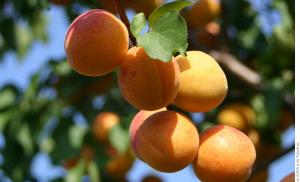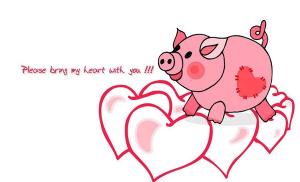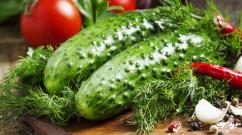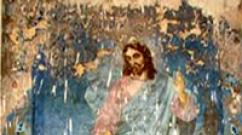Who has horns longer than the tail of the logician. Strange and rare animals (61 photos)
Deer are a group of artiodactyl animals belonging to the deer family of the same name. In total there are about 25 species of deer. Their closest relatives are roe deer, moose and muntjacs, and very distant ... giraffes.
Red deer (Cervus elaphus).
Deer are large animals, the size of different species can vary from 55 cm at the withers and a weight of 10-15 kg for a water deer to 155 cm in height and weight over 300 kg for red deer. All types of deer have a graceful body, thin, slender legs, a long neck and a relatively small head crowned with antlers. Deer antlers have a specific branched shape, the number of lateral processes is at least three and can increase depending on the age and type of deer. The shape of the horns also depends on the type of animal. Horns formed bone tissue(unlike the horns of bovids, in which they consist of horny substance) and are discarded annually. Only males wear antlers, with the exception of reindeer, in which both sexes have antlers.

The female deer are hornless.
The tail of deer is relatively short, in some species it can be fluffy and straighten out like a flower. All types of deer have a protective coloration, often brown (reindeer are gray), often there are white or yellowish spots on the body (for example, spotted deer, axis and fallow deer). Many species of deer are characterized by the so-called "mirror" spot of white fur on the animal's rump. It performs a signaling function because it is clearly visible during the run: so the deer does not lose sight of the mother in dense thickets, and other deer are warned of the danger in time, seeing the flickering croup of a fellow deer.

Deer usually move in jumps.
The distribution range of deer is very wide - they are found throughout the northern hemisphere: in Europe, Asia and North America. Almost all types of deer are forest dwellers, except for the reindeer that lives in the tundra. Different species inhabit various types of forest: mountainous, flat, dry woodlands or marshy swamps. Basically, these are sedentary animals, adhering to a certain area of \u200b\u200bthe forest, and only species living in the north can make winter migrations in search of food places. Regular migrations are characteristic of reindeer: in summer, these animals go north to the shores of the Northern Arctic Ocean to be saved from the vexing vile; by winter, they return south to the border of the taiga, where they are not strong winds and frost. In summer, deer live in herds of 3-5 individuals, only males and females are kept separately during the birth of offspring.

By winter, herds of deer are enlarged and can include up to 30-50 individuals.
The nature of these animals is rather secretive and shy, although where they are fed, they quickly get used to the human neighborhood.
Deer eat a variety of plant food- branches of trees and shrubs, herbs, various fruits (acorns, chestnuts, nuts, fruits), sometimes they eat lichens, berries and mushrooms. Reindeer eat mainly tundra lichens (moss moss), which is why their diet is very low in protein. To fill the need for protein food, they are forced to gnaw on discarded horns, bones, and even eat bird eggs. All deer love to lick salt, for this they visit salt licks - special places where the soil is rich in mineral salts.

The deer eats the needles.
Deer breed once a year. In northern species, the rut occurs in August-October, deer living in the south breed all year round. Usually silent, deer during the rut are transformed.

The male deer roars loudly, his cry is carried through the forest for a kilometer.
For their vocal exercises, males choose permanent place where they trample the ground with their hooves and break branches. In general, during the breeding season, deer are very warlike - they break bushes with their horns, peel off the bark on trees, and when they meet with an opponent, they engage in battle. Deer fights are by no means arbitrary.

The mating duel of deer.
Rivals do not disperse until they find out who is stronger, and the stronger one does not give mercy to the weak (unless he takes flight), deer often cause serious injuries to each other - they break horns, inflict deep wounds, and deaths are known.

In addition to butting, deer can fight with an opponent with their front legs, rearing up.
The male winner collects a harem of 3-10 females. After the end of the rut, the males shed their antlers, and new ones grow back by the next season. Deer pregnancy lasts an average of 6-7 months. Usually the female gives birth to 1, less often 2-3 fawns. Although the deer can stand on their legs from the first hours of their lives, they prefer to lie down in a secluded place for the first week.

All deer species have variegated coloration (except reindeer), which perfectly camouflages them in the forest.
The female feeds the cubs with milk for 3-5 months, but the young stay with their mother all autumn and winter until the next spring.

The female brought the deer into the herd.
Deer become sexually mature in the third year of life, but due to high competition with old animals, they begin to mate only at the age of 4-5 years. Deer live up to 20 years, but in nature they die at the age of 10-12.
In nature, deer have many enemies: in different parts range they can be hunted by wolves, lynxes, bears, cougars, leopards, tigers. Snowy winters greatly affect the number of deer. The fact is that it is difficult for deer to get food from under deep snow, and high snow cover makes it very difficult to move in the forest. As a result, deer weakened by starvation become easy prey for predators. Some exception is reindeer, which is well adapted to movement in the snow and is perfectly able to dig up reindeer moss in the snow.
Deer have always been a favorite prey of man, hunting them was considered the lot of the aristocracy. Despite this, the populations of many species of deer are perfectly preserved. This is facilitated by both the high fertility of these animals and special measures for their resettlement. In places where deer are protected, they are not afraid of humans and often visit roadsides, campsites and the outskirts of small towns. Some species of deer have become rare due to the destruction of natural habitats. For example, the David deer has completely disappeared in nature and the population of this species is maintained by breeding in zoos.

Pair of fallow deer (Cervus dama) in the autumn forest.
how a female deer protects a deer.
who has horns longer than tail?
Alternative descriptionsHouse. artiodactyl animal; Ukrainian name bagpipes
A tattered pet from the household of a certain Sidor
Eastern horoscope sign
On the body of this harmless pet, the ancient mythological Chimera wore three fire-breathing lion heads at once, and even the tail of a dragon.
Artiodactyl ruminant domestic animal
Weight carrying device
Fairy Dereza
Ukrainian wind musical instrument
Car or trolley for transporting fastening timber, rails and other pieces of equipment of relatively long length or for transporting ore and coke to blast furnaces with their manual loading
Mythic Amalthea
This animal owned a horn, which later became a cornucopia
This unpretentious animal was often called the "cow of the poor"
. "special cow for cats" according to Sharik from Prostokvashino
Russian folktale
Animal on state symbols of Chad
What animal skin did our ancestors call skin?
Whose body did the chimera have?
This is exactly what, according to the inhabitant of Prostokvashino, a cow is called for cats
. "who has horns longer than a tail?" (mystery)
The animal that gave the name of its foot to a cigarette
She has a goat husband
She left the kids at home and the wolf took advantage of it
Sidorov beast
Fairy horned mother of many children
Goes... horned
Amalthea who nursed Zeus
Odd-hoofed figure from fingers
Rowing fishing boat for fishing with nets in the Azov and Black Seas
. "hoof" combination of fingers
. "... Nostra"
The story of the Russian writer M. Zoshchenko
Ruminant animal of the bovid family
Pet
Sidorova...
finger figure
Sidor's bouncy creature
Dairy cattle
Cattle Sidor
Milk cattle with horns
Cattle that gives milk
horned animal
Mother of many children
Animal on the coat of arms of Samara
Dereza (story)
The rooster crows and she crows
Animal, supplementing. Sicilian "Nostra"
Gives milk and wool
Horned finger combination
domesticated goat species
She has a retired drummer
A pet with a roll-up leg
Ripped out by a certain Sidor
Horned mother (fab.)
Livestock
Following the little guys
small livestock
Horned-tattered sacrifice of Sidor
Sidor's pet "fiend"
Livestock
dairy pet
Rowing fishing boat on the Black and Seas of Azov
. "small" cattle
Horned cattle
. "goes ... horned for the little guys"
Dereza from a fairy tale
Small dairy cattle
She has an udder
. "addition" to nostra
Offended by Sidor
Horned cattle
Sacred beast in Zimbabwe
Gives milk
cattle with horns
Gesture two fingers up
horned pet
Domestic artiodactyl animal
Ukrainian name for the bagpipe
goat female
. "... Nostra"
. "Additive" to nostra
. "Goes... horned for the little guys"
. "Coming... horned"
. "Small-horned" cattle
Boxthorn
Sidor's pet "fiend"
A tattered animal named after Sidor
Ruminant
Animal, supplementing. Sicilian "Nostra"
horned creature
see goat
Who has horns longer than the tail
The skin of what animal our ancestors called the skin
This unpretentious animal was often called the "cow of the poor"
. "... nostra"
She has a goat husband
Animal with horns
Home "dereza"
Home "dereza"
In this post there will be scary, nasty, cute, kind, beautiful, incomprehensible animals.
Plus a short comment about each. They all really exist.
Watch and be amazed

SCHELEZUB- a mammal from the order of insectivores, divided into two main species: the Cuban flint tooth and the Haitian. Relatively large, relative to other types of insectivores, the beast: its length is 32 centimeters, and the tail, on average, 25 cm, the weight of the animal is about 1 kilogram, the physique is dense. 
MANED WOLF. Dwells in South America. The long legs of the wolf are the result of evolution in matters of adaptation to the habitat, they help the animal overcome obstacles in the form of tall grass growing on the plains. 
AFRICAN CIVETA- the only representative of the same genus. These animals live in Africa in open spaces with high grass from Senegal to Somalia, southern Namibia and eastern South Africa. The dimensions of the animal can visually increase quite strongly when the civet raises its hair when excited. And her fur is thick and long, especially on the back closer to the tail. The paws, muzzle and end of the tail are absolutely black, most of the body is spotty-striped. 
MUSKRAT. The animal is quite famous, thanks to its sonorous name. It's just a good photo. 
PROEKHIDNA. This miracle of nature usually weighs up to 10 kg, although larger specimens have also been noted. By the way, the length of the body of the prochidna reaches 77 cm, and this is not counting their cute five to seven centimeter tail. Any description of this animal is based on comparison with the echidna: the paws of the echidna are higher, the claws are more powerful. Another feature of the appearance of the prochidna is the spurs on hind legs ah males and five-fingered hind limbs and three-fingered forelimbs. 
CAPIBARA. Semi-aquatic mammal, the largest of modern rodents. It is the only representative of the capybara family (Hydrochoeridae). There is a dwarf variety of Hydrochoerus isthmius, sometimes considered as a separate species (small capybara). 
SEA CUCUMBER. Holothuria. sea pods, sea cucumbers(Holothuroidea), a class of invertebrates of the echinoderm type. Species eaten are common name"trepang". 
PANGOLIN. This post just couldn't do without it. 
HELL VAMPIRE. Mollusk. Despite its obvious similarity with the octopus and squid, scientists have identified this mollusk in a separate order Vampyromorphida (Latin), because as soon as it has retractable sensitive bee-shaped filaments. 
AARDVARK. In Africa, these mammals are called aardvark, which means "earth pig" in Russian. In fact, the aardvark appearance very strongly resembles a pig, only with an elongated muzzle. The ears of this amazing animal are very similar in structure to those of a hare. There is also a muscular tail, which is very similar to the tail of such an animal as a kangaroo. 
JAPANESE GIANT SALAMANDRA. To date, this is the largest amphibian that can reach 160 cm in length, weigh up to 180 kg and can live up to 150 years, although the officially registered maximum age of a giant salamander is 55 years. 
BEARDED PIG. In different sources, the bearded pig species is divided into two or three subspecies. These are the curly-haired bearded pig (Sus barbatus oi), which lives on the Malay Peninsula and the island of Sumatra, the Bornean bearded pig (Sus barbatus barbatus) and the Palawan bearded pig, which, judging by the name, live on the islands of Borneo and Palawan, as well as in Java , Kalimantan and the small islands of the Indonesian archipelago in South-East Asia. 

SUMATRAN RHINO. They belong to the equine-hoofed animals of the rhinoceros family. This species of rhinoceros is the smallest of the entire family. The body length of an adult Sumatran rhinoceros can reach 200 - 280 cm, and the height at the withers can vary from 100 to 150 cm. Such rhinos can weigh up to 1000 kg. 
SULAWESI BEAR CUSCOUS. An arboreal marsupial living in the upper tier of lowland tropical forests. The coat of the bear couscous consists of a soft undercoat and coarse guard hairs. Color ranges from gray to brown, with a lighter belly and limbs, and varies by geographic subspecies and age of the animal. The prehensile, hairless tail is about half the length of the animal and acts as a fifth limb, which makes it easier to move through the dense rainforest. Bear couscous is the most primitive of all couscous, retaining primitive tooth growth and skull features. 
GALAGO. Its large fluffy tail is clearly comparable to that of a squirrel. And the charming muzzle and graceful movements, flexibility and insinuation, clearly reflect his feline trait. The amazing jumping ability, mobility, strength and incredible agility of this animal clearly show its nature as a funny cat and elusive squirrel. Of course, it would be where to use their talents, because a cramped cage is very poorly suited for this. But, if you give this little animal a little freedom and sometimes allow him to walk around the apartment, then all his quirks and talents will come true. Many even compare it to a kangaroo. 
WOMBAT. Without a photograph of a wombat, it is generally impossible to talk about strange and rare animals. 
AMAZONIAN DOLPHIN. Is the largest river dolphin. Inia geoffrensis, as scientists call it, reaches 2.5 meters in length and weighs 2 centners. Light gray juveniles lighten with age. The body of the Amazonian dolphin is full, with a thin tail and a narrow muzzle. A round forehead, a slightly curved beak and small eyes are the features of this species of dolphins. There is an Amazonian dolphin in rivers and lakes Latin America. 
FISH-MOON or MOLA-MOLA. This fish can be over three meters long and weigh about one and a half tons. The largest specimen of the moonfish was caught in New Hampshire, USA. Its length was five and a half meters, data on weight are not available. In shape, the body of the fish resembles a disk; it was this feature that served as the reason for Latin name. The moonfish has thicker skin. It is elastic, and its surface is covered with small bony protrusions. Fish larvae of this species and juveniles swim in the usual way. adults big fish swim on their side, quietly moving their fins. They seem to lie on the surface of the water, where they are very easy to notice and catch. However, many experts believe that only sick fish swim in this way. As an argument, they cite the fact that the stomach of fish caught on the surface is usually empty. 
TASMANIAN DEVIL. Being the largest of modern predatory marsupials, this animal is black in color with white spots on the chest and rump, with a huge mouth and sharp teeth, has a dense physique and severe disposition, for which, in fact, it was called the devil. Emitting ominous cries at night, massive and clumsy Tasmanian devil superficially resembles little bear: front legs slightly longer than the hind legs, big head, the muzzle is blunted. 
LORI. Feature lori - big size eyes, which may be bordered by dark circles, between the eyes there is a white dividing strip. The muzzle of a lory can be compared to a clown mask. This most likely explains the name of the animal: Loeris means "clown" in translation. 
GAVIAL. Of course, one of the representatives of the detachment of crocodiles. With age, the muzzle of the gharial becomes even narrower and longer. Due to the fact that the gharial feeds on fish, its teeth are long and sharp, located with a slight inclination for the convenience of eating. 
OKAPI. FOREST GIRAFFE. Traveling through Central Africa, journalist and explorer of Africa Henry Morton Stanley (1841-1904) more than once encountered local natives. Having once met an expedition equipped with horses, the natives of the Congo told the famous traveler that they had wild animals in the jungle, very similar to his horses. The Englishman, who had seen a lot, was somewhat puzzled by this fact. After some negotiations in 1900, the British were finally able to acquire parts of the hide. mysterious beast from the local population and send them to the Royal Zoological Society in London, where the unknown animal was given the name "Johnston's Horse" (Equus johnstoni), that is, it was assigned to the horse family. But what was their surprise when, a year later, they managed to get a whole skin and two skulls of an unknown animal, and find that It looks more like a pygmy giraffe of the times ice age. Only in 1909 was it possible to catch a live specimen of Okapi. 
VALABY. WOOD KANGAROO. To the genus Tree kangaroos - wallabies (Dendrolagus) include 6 species. Of these, D. Inustus or bear wallaby, D. Matschiei or Matchish wallaby, which has a subspecies D. Goodfellowi (Goodfellow wallaby), D. Dorianus - Doria wallaby, live in New Guinea. In Australian Queensland, there are D. Lumholtzi - Lumholtz's wallaby (bungari), D. Bennettianus - Bennett's wallaby, or tharibina. Their original habitat was New Guinea, but now wallabies are also found in Australia. tree kangaroos live in the tropical forests of mountainous regions, at an altitude of 450 to 3000m. above sea level. The body size of the animal is 52-81 cm, the tail is from 42 to 93 cm long. Wallabies weigh, depending on the species, from 7.7 to 10 kg males and from 6.7 to 8.9 kg. females. 
WOLVERINE. Moves quickly and dexterously. The animal has an elongated muzzle, a large head, with rounded ears. The jaws are powerful, the teeth are sharp. Wolverine is a “big-legged” animal, the feet are disproportionate to the body, but their size allows them to move freely through the deep snow cover. Each paw has huge and curved claws. Wolverine climbs trees perfectly, has sharp eyesight. The voice is like a fox. 
FOSS. On the island of Madagascar, such animals have been preserved that are not found not only in Africa itself, but throughout the rest of the world. One of the rarest animals is Fossa - the only representative of the genus Cryptoprocta and the largest predatory mammal that lives on the island of Madagascar. The appearance of the fossa is a bit unusual: it is a cross between a civet and a small cougar. Sometimes the fossa is also called the Madagascar lion, since the ancestors of this animal were much larger and reached the size of a lion. Fossa has a squat, massive and slightly elongated body, the length of which can reach up to 80 cm (on average it is 65-70 cm). The legs of the fossa are long, but thick enough, with the hind legs higher than the front ones. The tail is often equal to the length of the body and reaches 65 cm. 
MANUL approves of this post and is only here because it should be. Everyone knows him. 
FENEC. STEPPE FOX. He agrees with the manula and is present here in so far as. After all, everyone saw him. 
THE NAKED DIGGER puts the manula and the fennec fox in karma and invites them to organize a club of the most feared animals in Runet. 
PALM THIEF. A representative of the decapod crustaceans. The habitat of which is the western part Pacific Ocean and tropical islands indian ocean. This animal from the family of land crayfish is quite large for its species. The body of an adult individual reaches a size of up to 32 cm and a weight of up to 3-4 kg. For a long time, it was erroneously believed that with its claws, it can even crack coconuts, which it then eats. To date, scientists have proven that cancer can only eat already split coconuts. They, being its main source of nutrition, gave the name palm thief. Although he is not averse to eating other types of food - the fruits of Pandanus plants, organic matter from the ground and even their own kind.
Interesting quizzes for children about animals that live in the forest, which children can see in the zoo, about pets. All quiz questions are accompanied by answers.
Quiz "Who am I?"
■ “I am very large, about two meters tall, and my weight is 350 kg. I have brown hair, small ears and a tail. I can walk on my hind legs and climb trees in search of food. And I eat fish, berries, I can eat ants, worms and beetle larvae. I spend the whole winter hibernating, and in the spring I leave the lair thin, hungry and angry. (Bear.)
■ “I live on Far North. I eat fish and seals. I love the sea very much. A thick layer of fat under the skin and a long white coat protect me from hypothermia. And my paws are like flippers, so I'm a good swimmer and I'm not afraid to swim far into the sea. (Polar bear.)
■ “I have a sharp muzzle, erect ears, a very finely developed sense of smell. I am very greedy. I eat meat, attacking deer, elk, rodents, but sometimes, when I can’t find anything, I survive on plant food - berries. I like to hunt at night, alone. Sometimes I chase prey for hours, running not a single kilometer. But in winter, in order to feed ourselves, we gather in flocks. (Wolf.)
■ "I'm fat funny animal with sharp front teeth. My house is called a hut. I choose a small river or stream with running water as a place for my hut. I cut tree branches with my teeth and build a dam out of them to keep the water at a constant level and always have an underwater connection with the dwelling. There are two “rooms” in the hut: a bedroom and a pantry. (Beaver, or beaver.)
■ “I have a very keen sense of smell. The biggest treat for me - field mice. A mouse squeaks a little - and I can hear it from a hundred meters away, even in winter, when it hides under the snow. I can eat up to 20 of them a day. I hunt at night, and during the day I like to relax. Often they call me a red cheat. (A fox.)
■ “I live with my family in a burrow that I dug with my front paws and lined with soft grass and down. I am very careful. Before approaching the mink, I will make a few jumps to the side, then a few jumps to the other side, and only then do I jump into my house. In winter, in order to be invisible in the snow, I change my fur coat. (Hare.)
■ “I have very beautiful antlers, but every winter I have to shed them. The body is covered with beautiful small light specks. Wool protects well from frost, and wide hooves do not allow me to fall through the snow. I pride myself on good eyesight, and my hearing and sense of smell allow me to special work detect danger. (Deer.)
■ “I look like a clumsy fat mouse with big cheeks. I have round shiny eyes, short legs and a pointed little tail.
I build a mink at a depth of 1-2 meters underground, which consists of several "rooms": in one I sleep in the winter, and in the other I store supplies. Sometimes they keep me at home, in a cage.” (Hamster.)
■ “I, small and gray, build myself a mink either in a field or in a forest, under the roots of trees in a secluded place. My mink is like a bird's nest. Here I store seeds, berries, nuts, dry buds and roots of herbs and trees. In winter, I often go out of my mink to replenish my supplies. To do this, I dig special tunnels and move along them. (Mouse.)
■ “I, a kind fussy little animal, live everywhere. I have a long fluffy tail and beady eyes. tail, almost equal to the length my body (about 20 cm), serves as a pole and an umbrella for me, allowing me to maintain balance and jump on the branches. There are small tassels on the ears that protect my ears from frost. On severe frosty days, I sit in a hollow and eat acorns, dry mushrooms, nuts. Squirrel.
■ "I little animal with velvety dark gray fur. I have strong front paws, like large shoulder blades. Claws grow on them, with which I dig the earth and throw it back. I have eyes, but they are just tiny beads covered in fur and skin. I don't need eyes, as I constantly live underground in pitch darkness. But I have a great sense of smell. I smell earthworm for a few meters. (Mole.)
Quiz "At the Zoo"
■ “My body is unusually heavy, it can weigh like a big truck. It is in order to hold such a weight that my legs are thick and look like huge columns. I have tusks with which I defend myself. The most remarkable part of my body is the trunk. I like to eat grass, fruits and leaves of trees. (Elephant.)
■ "I live in the thicket rainforest, where Sun rays thin strips break through the crowns of dense trees. Therefore, my skin is covered with stripes that look like these patches of light. I strong beast. I eat wild boars, deer, antelopes. To satisfy my hunger, I need about nine kilograms of meat a day.” (Tiger.)
■ “I am a strong animal. My roar is like thunder, and my mane gives me a menacing look. I live in warm countries, in sandy places, so my skin is sandy in color. During the day I sleep more often, and at night I hunt zebras, gazelles and antelopes. Although I am the king of animals, I am easy to train and can perform various numbers in the circus. (A lion.)
■ “My body is covered with tough, thick skin of gray color, which protects well from insect bites and from branches of bushes. On the feet are small hooves. I eat grass and young branches and leaves. But mine main feature- the famous horn on the forehead. When danger threatens me, I lower my head and strike with the horn.” (Rhinoceros.)
■ “Everyone knows me. I look like a man, but unlike him, I have a tail with which I hold on to branches while I pick fruits with my hands and bring them to my mouth with my feet. My favorite thing to do is make faces.” (Monkey.)
■ “The ancient Greeks called me “river horse”. Firstly, I spend a lot of time in the water, and secondly, I resemble a horse. I have such big wide nostrils and small ears. I am a very large animal: 4 meters long and 3.5 tons in weight. I eat river grass. (Hippopotamus.)
■ “My height can reach a height of six meters. On the head there are ears and funny little horns covered with leather. I don't have fangs or claws. But there is an unusually long tongue, sometimes reaching 45 cm. With this tongue, I deftly pluck leaves from thorny plants without even pricking myself. Although my front legs are longer than my hind legs, I run fast, I can overtake a horse. I sleep standing up and drink water with my legs wide apart, because my Long neck doesn't bend at all." (Giraffe.)
■ “I have thick gray skin, a small head with ears sticking up, very long and strong hind legs and small front legs. I am a rather big animal (about two meters in height), but I jump like a grasshopper - far and high. The most remarkable thing about me is the bag, which is located in the lower abdomen, between the legs. My image is on the coat of arms of Australia. (Kangaroo.)
■ “I am like a little horse: I have hooves, a mane, a tail. I run fast. I have excellent eyesight and a good memory. But the color is striped. I have many enemies: tigers, lions, hyenas and other predators. To protect ourselves from enemies, I and my other relatives unite in groups. I am listed in the Red Book. (Zebra.)
■ “I feel quite well where other animals would die of hunger and thirst. I carry my food and drink with me in my humps. Before starting the next trip, I eat and drink a few days. Then only one of my hump can weigh 45 kilograms! But towards the end of the journey, my hump becomes empty and falls to one side. (Camel.)
Quiz "We are responsible for those we have tamed"
■ What hardy animal was used in ancient wars to harness them to chariots? (Horse.)
■ What animal has a thick body, short legs, small hooves, and fangs that stick out? (At the pig.)
■ Are the eyes of cats the same day and night? (At night, the pupils of cats are too dilated, and during the day they are small.)
■ Which pet is true friend human? Dog.
■ What useful animal gives meat, milk, sour cream, cottage cheese, butter? (Cow.)
■ Which one of the first domesticated animals is the closest relative of horses, only smaller than they are? (Donkey.)
■ What pet provides healthy milk, meat, wool, and down? (Goat.)
■ From the skin of which pet do sheepskin coats, hats and mittens? (From sheepskin.)
■ Which animal is easy to recognize by long ears and the tassel at the end of the tail? (Donkey.)
■ What is the animal for the inhabitants of the North and transport, and food, and clothing, and housing? (Deer.)
■ What animal provides us with meat, lard, and leather used to make shoes, gloves, and bags? (Pig.)
■ From the milk of this animal, a delicious salty cheese is made - feta cheese. (From sheep's milk.)
■ What pets live in cage houses with mesh floors? (Rabbits.)
■ Which pet gives people honey? (Bee.)
■ What is the favorite animal in the house? (A cat.)
Quiz "Live Corner"
■ Award at the cat show (Rosette.)
■ Parakeet. (Ara.)
■ Synonymous with "smell" for dogs and cats. (Sniff.)
■ Scottish Shepherd. (Collie.)
■ Breed of dogs - ...-schnauzer. (Rizen.)
■ White with a yellow tufted parrot. Can speak. (Cockatoo.)
■ One that walks by itself. (Cat.)
■ Chinese - Pekingese, Japanese - ... (Hin.)
■ Home ... - a norushka in a cage, inside of which there is a tiny house. (Mouse.)
■ Russian Blue, Siberian, Persian, Scottish, Oriental, Siamese and other breeds of these beauties. (Cat.)
■ An African parakeet that will not survive alone in the wild or in a cage. A motley handsome man with a girlfriend have one drawback - they are too loudly accommodating. (Lovebird.)
■ Charming affectionate tropical semi-monkey with big eyes and the New Guinea red and blue parrot are named the same. How? (Lori.)
■ American and English... spaniels accurately look for drugs. (Coker.)
■ Blue Cuban ... with its claws quickly chop off the tail of any fish. Therefore, they are kept separately or with ampullar snails. (Cancer.)
■ Experienced terrarium keepers breed this species of snake despite the difficulty of feeding it. (Slider)
■ Large working dog. (Dog.)
■ Bell mosquito larva, favorite food aquarium fish. (Motyl.)
■ With repeated repetition of this word, a cat with any nickname will do. (Kis.)
■ Breed of dogs with numerous subspecies: Afghan, Russian canine, greyground, Italian greyhound, etc. (Borzoi.)
Interesting questions about animals with answers for primary school students can be used as a preparation for the Olympiad on the world around, ecology. And also as additional material in the classroom, quiz questions or the release of an educational newspaper with the children.
Interesting questions about animals
1. What are the names of mosquitoes and other blood-sucking insects that bother animals and humans? (Gnus)
2. What do bees make honey from? (from flower nectar)
3. Where do crayfish hibernate? (In underwater burrows of fresh water)
4. Who will be born four times before becoming an adult? (Many insects, they have 4 stages of development - egg, larva, pupa, adult insect)
5. How do ants get across streams and ditches? (They make a living bridge, grappling with each other with legs and jaws, the rest of the ants pass through this bridge)
6. What will happen to a bee when it stings a person? (The bee will die because the sting gets stuck in the elastic skin; the bee, when pulling out the sting, tears it off along with the end of the abdomen)
7. How does a grasshopper chirp? (Cracking is obtained from the friction of one elytron from another)
8. What beetles are named after the month in which they appear? Chafer)
9. Whose "wife" is a bloodsucker? (In a mosquito, horsefly, because only the female bites, and the male feeds on plant nectar)
10. Who is called the forest "lantern"? (Glowworm)
11. Who is called a small deer who can buzz? (Bug)
12. Insects working for humans? (bee silkworm)
13. Who is called a bee wolf, and who is called a bee tiger? (Wasp philanthus, hornet)
14. What is the name of the worm-shaped butterfly larva? (Caterpillar)
15. What is the name of the male in the bee family? (Drone)
16. Why does a mosquito squeak? (Sounds are made when his wings move)
17. How many legs do beetles have? (Six)
18. How many legs do spiders have? (Eight)
19. How does a spider sitting in ambush know that prey has got into its web? (Along the signal threads that sway when the prey moves)
20. How can you find out about the approach of rain by watching an anthill? (Ants hide and close the passages)
21. What is the name of the "musician" behind the stove? (Cricket)
22. What is the name of the fastest flying insect? (Dragonfly)
23. How do spiders fly? (attached to the web)
24. About whom can you say that he is "out of his skin"? (Cancer, crab, many insects, snake)
25. About whom they say "red as cancer"? What color is he really? (Cancer, brown in color, but turns red when cooked)
26. What is the name of the "scissors" that walk along the bottom of the river? (Cancer)
27. Who has teeth in their stomach? (A crab has 3 teeth in its stomach)
28. Who has a skeleton outside? (All arthropods have crayfish, insects, spiders, etc. The chitin cover replaces their skeleton)
29. Who has ears on their feet? (A grasshopper has hearing organs on the shins of its front legs)
30. Where do butterflies winter? (In cracks, cracks under the bark and some fly south to warm countries)
31. Who is called "living flowers"? (Butterflies)
32. Is there an animal with one eye? (Rachok - cyclops)
33. Who builds a house under water from the air? (Silver water beetle)
34. Who builds a hut without corners in the forest without axes? (Ants)
35. What butterfly is called the bird's eye? (peacock eye)
36. Subtract one letter from the arachnid, will a fish appear? (flare - bream)
37. How many wings does a beetle have? (4, two elytra and two wings)
38. What does a toad eat in winter? (The toad does not eat in winter, it sleeps)
39. Which legs grow earlier in a tadpole - front or back? (Rear)
40. What will happen to the frog if you dig it out from under the snow and bring it close to the fire? (She will die from a rapid change in temperature)
41. Where in Russia do frogs and snakes not live? (On the Kamchatka Peninsula)
42. Why don't birds and animals touch toads? (Toads release poisonous substances)
43. What animals are called "sea nettles"? (Jellyfish)
44. What do tadpoles eat? (Parts aquatic plants, the simplest animals)
45. Which animal's eyes can look in different directions independently of each other? (chameleon)
46. What kind of fish make nests? (A stickleback, the male builds a nest of algae and guards the laid eggs)
47. Which fish is flat and lies at the bottom? (Flounder)
48. What is the name of a marine animal that lives at the bottom of the ocean; spherical body, covered with needles (Sea urchin)
49. What fish catch prey:
Water jet (Sprinkler from Southeast Asia)
fishing rod ( Angler from the Atlantic Ocean)
Electricity (Electric ramp, electric eel, stargazer)
50. What is the name of a sea animal that looks like a chess piece? (Sea Horse)
51. What do surgeons do at sea? (They live. A surgeon is the name of a detachment of tropical fish)
52. Which animal lives the longest? (Turtle - up to 300 years old , raven - up to 300 years)
53. What is the name of a predator inhabiting the seabed, it attacks prey several times larger than itself in size; has 8 tentacles? (Octopus)
54. What benefits do nature bring earthworms? (They loosen the earth, increasing soil fertility)
55. How can you recognize a hedgehog? (By yellow spots and yellow shields on the head)
56. What is the name of a desert dweller who carries his house on his back? (Turtle)
57. What is the name legless lizard? (Spindle)
58. Who, having one leg, also wears a house on himself? (Snail)
59. What is the name of a desert lizard up to 1.5 meters long? (Varan)
60. What fish spend most of their time on land? (Spiky jumpers living in the tropics)
61. Who rides the sea - the ocean on a shark? (Fish are sticky)
62. What dog does not bark? (Fish - dog)
63. What acorn does not grow on oak? (Sea acorn - one of the barnacles)
64. Who swims tail first? (Pumpkin fry)
65. What are the inhabitants of the sea called who carry tools with them? (Saw fish, hammer fish, knife fish, etc.)
66. Where are pearls "born"? (In clam shells)
67. Why do crocodiles cry? (At the sight of food, they begin to produce a huge amount of secretory fluid, which is secreted through the tear ducts of the eyes)
68. Who is heavier: the most big shark or an elephant? (Whale shark)
69. Do fish distinguish colors? (Yes, but differently than human)
70. Do fish close their eyes when they sleep? (No, they don't have eyelids)
71. What lizard hunts deer and wild boar? (giant lizard)
72. Which snake has horns? (At the horned viper)
73. Which animal has a tongue longer than the body? (At the chameleon)
74. What animal can change its color depending on environment? (Chameleon, octopus, flounder, tree frog, etc.)
75. What fish are considered "fake" due to the lack of a swim bladder? (Sharks, rays, etc.)
76. Which clam swims the fastest? (Squid)
78. What animals lead an underground lifestyle? (Mole, shrew, some insects, worms, etc.)
79. What animal is afraid of water but loves to bathe? (Cat)
80. What animal is wearing a vest? (Zebra)
81. What animal is the most large mammal? (Whale, blue whale - up to 150 t/)
82. What fish does a whale eat? (He does not eat fish, but filters small crustaceans through a whalebone)
83. Where is it more convenient for a hare to run uphill or uphill? (On the mountain, because the hare has front legs shorter than the hind legs)
84. Why is it said that the feet feed the wolf? (He runs after prey)
85. Who else will have babies in the fall? (At a hare, rabbits are called "leaflets")
86. What animals are called "rods"? (Bears awake in winter)
87. Which cow lives better, tailed or tailless? (Tailed, it is easier for her to drive away flies that interfere with her)
88. Who gives birth to cubs in the Siberian forest in winter? (At the squirrel)
90. What is the most enduring pet? (camel, deer)
91. What saves a camel from the heat? (Thick and dense fur, subcutaneous fat)
92. Who gets taller when sitting down? (Dog, cat, wolf, etc.)
93. What animal carries all his money with him? (Pig with a heel)
94. Why the pig is not afraid snake bite? (Layer subcutaneous fat the pig is poor blood vessels, the poison does not penetrate into the blood)
95. What animal can stay underwater for 20 minutes? (Hippopotamus)
96. Ships of the Desert (Camel)
97. Sled dog (Laika and others)
98. One of Thumbelina's suitors in a velvet coat? (Mole)
99. Dam Builder (Beaver)
100. How to connect the fingers of the hind legs of a beaver? (With the help of eardrums)
101. What does a hare eat in winter? (bark of trees, branches of shrubs)
102. White as snow, fluffy and small. The tail got dirty in the soot. (Ermine)
103. What are the teeth that stick out of the mouth very strongly - incisors or canines? (Tusks of elephants and walruses)
104. What is the name of a fenced area for keeping animals? (Aviary)
105. What is the name of fermented milk drink made from mare's milk? (Kumiss)
106. What animals fly? (Bats, flying squirrels, etc.)
107. Why are old moose called "elks"? (They have horns like a plow)
108. Who has a horn on his nose? (At the rhinoceros)
109. What animal builds a nest on the grass and low bushes? (Mouse is a baby)
110. When do squirrels grow tassels on their ears? (in winter)
111. What animal is an excellent digger? (Mole, shrew)
112. Who gathers pine nuts in the forest together with a man? (Chipmunk, nutcracker, etc.)
113. Do animals eat fly agaric? (Yes, they are treated with them)
114. What animal is called a dog with a cat's head? (cheetah)
115. Are rabbits born blind or sighted? (Sighted, able to move, 5-10 days after birth, they begin an independent life)
116. Why don't they hunt fur-bearing animals in spring? (They molt and hatch their young)
117. What is the name of the long-haired Asian bull? (Yak, sarlik)
118. What is the name of the largest mammal:
a) predatory (Polar bear - up to 1 ton)
b) herbivore (elephant - up to 7.5 tons)
c) domestic (bull - up to 1.2 tons)
119. Can a horse distinguish colors? (Yes, some)
120. Do lions climb trees? (Sometimes they sleep in trees)
121. What animal was first domesticated by man? (Dog)
122. How to write a mousetrap in five letters? (Cat)
123. What ungulate animal has a note in the name "la"? ( Roe)
124. African animal with the largest ears in the world (Elephant)
125. Main beast of burden in the Andes (Lama)
126. What shaggy animal with a pained expression of the muzzle hangs upside down on a tree for hours? (Sloth)
127. Which animal is the long jump animal champion? (Kangaroo)
128. The coat of a hare becomes white, that of a squirrel - gray, that of a polar fox - white or gray-blue. What is it? (Molt)
129. What animal is the tallest? (Giraffe)
130. What animals are considered sacred in India? (Cows, some monkeys)
131. Which animal breathes through one nostril? (Sperm whale)
132. Which animal plows the bottom with fangs? (Walrus)
133. Can a newborn dolphin or a whale drown? (Yes, he has no air in his lungs, so his mother should immediately push him to the surface of the water)
134. What scary beast woods loves raspberries? (Bear)
135. How many can swim polar bear? (600 km from the coast)
136. If you deprive a predator of a letter, you get a domestic animal. (Wolf - ox)
137. Which predator has the smallest heart? (At the lion)
138. In what animal is the body covered with a shell of horny scutes? (Battleship)
139. What is the thickest-skinned animal? (Hippopotamus)
140. What rodent has a tail longer than the body? (Jerboa)
141. Which dog has a tongue of blue color? (Chow - chow)
142. What animal of Australia has a duck nose? (Platypus)
143. What is the name of one of the most beautiful predatory cats that has the longest thick fur and lives in the mountains? (Irbis or snow leopard)
143. What is the name of the wild Australian dog? (Dingo)
144. What is the name of an extinct mammal that looks like an elephant? (Mammoth)
143. What animal wears a bush on its head? (Deer)
144. What animal in the stories of V. Bianchi is called "forest kolobok"? (Hedgehog)
145. What animal is the smallest predatory animal? (Weasel, weight no more than 100 g, body length no more than 15 cm)
146. What is the difference between a male lion and a lioness? (Thick mane of long hair)
147. Does a bear lie down in a lair skinny or fat? (bold)
148. Who runs with hind legs forward? (Hare)
149. Who grows teeth every day? (in rodents)
150. What animal is our smallest animal? (Baby shrew, 3.5 cm long)
151. What is the name of a large and dangerous forest cat? (Lynx)
152. What is the name of a rodent that lives in the steppes and semi-deserts? (Gopher)
153. What is the name of an animal that walks by itself? (Cat)
154. What is the name of the mammal, laying eggs? (platypus, echidna)
155. Why does a dog stick out its tongue when it is hot, but not a horse? (A dog does not have sweat glands on its body like a horse. It sticks out its tongue to cool the body)
156. What animal does not eat neither a fox nor a polecat? (A shrew, it emits a strong smell)
157. What forest animal dries mushrooms on trees? (Squirrel)
158. What mountain animal puts stacks of hay? (Senostavka or pika)
160. When is a white hare the most noticeable? (When it sheds before the snow melts or falls)
161. Where do bats go for the winter? (They sleep in hollows, in attics in caves)
162. Are all hares white in winter? (Only hares turn white - hare hare remain gray)
163. What do newborn bats eat? (Mother's milk)
164. Who appears earlier in spring: bats or insects? (Bats appear after the insects they feed on)
165. What does a hedgehog do in winter? (asleep)
166. What small animal sleeps upside down? (Bat)
167. What animal in old Russia was called "cows of the poor"? (Goat)
Vagina Lyudmila Gennadievna, MBOU "Secondary School No. 92", primary school teacher, Novokuznetsk, Kemerovo region
To download material or !












